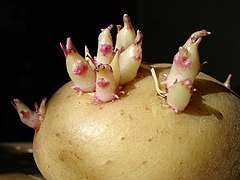Solanum tuberosum
| Habit | herbaceous
| |
|---|---|---|
| Height: | ⇕ | 18 in"in" can not be assigned to a declared number type with value 18. to 24 in"in" can not be assigned to a declared number type with value 24. |
| Width: | ⇔ | 18 in"in" can not be assigned to a declared number type with value 18. |
| Lifespan: | ⌛ | perennial |
| Exposure: | ☼ | sun |
|---|---|---|
| Features: | ✓ | edible |
| USDA Zones: | 7 to 11 | |
| Flower features: | ❀ | blue, purple, white |
|
Solanum > |
The potato is a starchy, tuberous crop from the perennial Solanum tuberosum of the Solanaceae family (also known as the nightshades). The word potato may refer to the plant itself as well as the edible tuber. In the region of the Andes, there are some other closely related cultivated potato species. Potatoes are the world's fourth largest food crop, following rice, wheat, and maize.[1]
Potato plants are herbaceous perennials that grow about 60 cm (24 in) high, depending on variety, the culms dying back after flowering. They bear white, pink, red, blue, or purple flowers with yellow stamens. The tubers of varieties with white flowers generally have white skins, while those of varieties with colored flowers tend to have pinkish skins.[2] Potatoes are cross-pollinated mostly by insects, including bumblebees, which carry pollen from other potato plants, but a substantial amount of self-fertilizing occurs as well. Tubers form in response to decreasing day length, although this tendency has been minimized in commercial varieties.[3]
After potato plants flower, some varieties produce small green fruits that resemble green cherry tomatoes, each containing up to 300 true seeds. Potato fruit contains large amounts of the toxic alkaloid solanine and is therefore unsuitable for consumption. All new potato varieties are grown from seeds, also called "true seed" or "botanical seed" to distinguish it from seed tubers. By finely chopping the fruit and soaking it in water, the seeds separate from the flesh by sinking to the bottom after about a day (the remnants of the fruit float). Any potato variety can also be propagated vegetatively by planting tubers, pieces of tubers, cut to include at least one or two eyes, or also by cuttings, a practice used in greenhouses for the production of healthy seed tubers. Some commercial potato varieties do not produce seeds at all (they bear imperfect flowers) and are propagated only from tuber pieces. Confusingly, these tubers or tuber pieces are called "seed potatoes".
Read about Solanum tuberosum in the Standard Cyclopedia of Horticulture
|
|---|
|
Solanum tuberosum, Linn. Potato. Low, weak-stemmed, much-branched perennial with tender, herbaceous tops, and perpetuating itself asexually by means of thickened or tuberous underground sts., glabrous or pubescent-hirsute: lvs. unequally pinnate, the 5-9 oblong-ovate lfts. interposed with much smaller ones: fls. variable in color, white passing through various tints and shades of purple, violet, and blue, in long-stemmed dichotomous clusters: fr. a globular berry 1/2- l in. or more in diam., usually through lack of viable pollen not produced in the highly developed modern varieties except in favored localities and in the case of certain varieties, but fruiting abundantly in S. Chile and in Peru. Temp. Andes of Peru and Bolivia. See Potato. CH
|
Cultivation
At harvest time, gardeners usually dig up potatoes with a long-handled, three-prong "grape" (or graip), i.e., a spading fork, or a potato hook.
Propagation
Potatoes themselves are generally grown from the eyes of another potato and not from seed. Home gardeners often plant a piece of potato with two or three eyes in a hill of mounded soil.
Pests and diseases
Varieties
There are about five-thousand potato varieties worldwide. Three thousand of them are found in the Andes alonewp. They belong to eight or nine species, depending on the taxonomic school. Apart from the five-thousand cultivated varieties, there are about 200 wild species and subspecies.wp
Popular varieties (cultivars) includewp:
|
|
|
Gallery
References
- ↑ http://www.hort.purdue.edu/rhodcv/hort410/potat/po00001.htm
- ↑ Growing Food: A Guide to Food Production ISBN 1402066244
- ↑ Regulation of potato tuberization by daylength and gibberellins
- ↑ "Papas Nativas de Chiloé – Descripción de tuberculos". Papasnativas.cl. Retrieved on 6 December 2009.
External links
- w:Solanum tuberosum. Some of the material on this page may be from Wikipedia, under the Creative Commons license.
- Solanum tuberosum QR Code (Size 50, 100, 200, 500)








